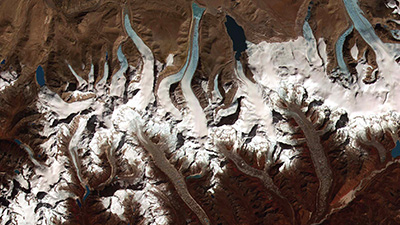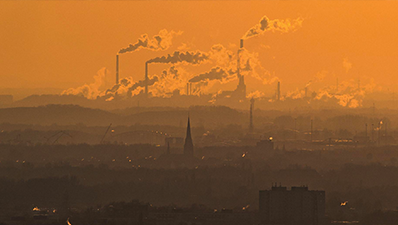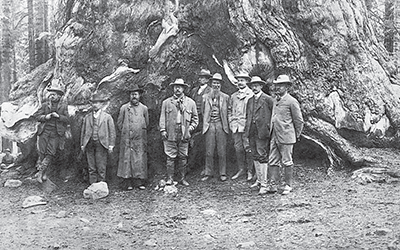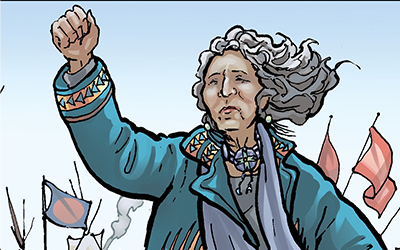Technological Advances: Debates About the Environment After 1900
Teacher Resources
Driving Question: What role have technological advancements played in both worsening and mitigating environmental challenges?
Humanity’s impacts on the planet have become so profound that many scholars believe we have entered a new geological epoch, the Anthropocene, in which human activity has become the dominant impact on climate and the environment. There are over 8 billion of us on this planet. Our machines are powered by fuels that emit greenhouse gases that drive climate change. Our patterns of consumption and production are transforming ecosystems and polluting the Earth’s air, land, and water. At the same time, other species on the planet are rapidly disappearing. Still, the future is unwritten, and you have a part to play in shaping it. What will the world of tomorrow look like? What historical frames can help you prepare for what’s to come?
Learning Objectives
- Explain the causes and effects of environmental changes in the period from 1900 to the present.
- Use close reading skills to evaluate the impact of globalization on the environment.
Vocab Terms:
- Anthropocene
- biodiversity
- climate change
- deforestation
- drought
- emissions
Opener: Technological Advances: Debates About the Environment After 1900
To teach this lesson step, refer to page 3 of the Lesson 9.3 Teaching Guide.
Have you ever thought about how the things you use every day might affect the Earth? Let’s talk about how these items impact the environment.
The Anthropocene
To teach this lesson step, refer to page 3 of the Lesson 9.3 Teaching Guide.
Humans are altering the biosphere (the air, land, and water that makes up the Earth). Some scientists seek to highlight this process by calling the current epoch of geological time the Anthropocene. Do you think we’re living in a new epoch?
-
Guiding Questions
-
Before you read
Preview the questions below, and then skim the article. Be sure to look at the section headings and any images.
While you read
Look for answers to these questions:
- What is the other geological name for the Anthropocene?
- What does the graph “Human Influences on Global Temperature” (figure 2.1) illustrate?
- Using the same reference, compare the period between 1880 and 1940 and that between 1940 and 2020. What do you notice?
- What is the current rate of decline in the biodiversity of all sectors of the planet?
- What do Three Mile Island (US), Chernobyl (Ukraine), and Fukushima (Japan) have in common?
- How long do many scientists believe we have left to address global climate change? How might we correct our ongoing impact on the environment?
After you read
Respond to the following questions:
- How does climate change influence human rights? Who is most affected by climate change?
- Are different perspectives on climate change helpful, harmful, or both?
Population and Environmental Trends, 1800 to the Present
To teach this lesson step, refer to page 5 of the Lesson 9.3 Teaching Guide.
After growing relatively slowly for millennia, the human population has exploded in the last two hundred years, starting with the Industrial Revolution. This article explores how this demographic shift has impacted our climate, in monumental ways.
-
Guiding Questions
-
Before you read
Preview the questions below, and then skim the article. Be sure to look at the section headings and any images.
While you read
Look for answers to these questions:
- What have been the general trends in global population over the long span of human history?
- What has been the trend in the past two hundred years in terms of the percentage of people living in cities?
- How has industrialization changed atmospheric CO2 levels, and why does that matter?
- What have been some health effects of fossil fuel use?
After you read
Respond to the following questions:
- The author ends this article by arguing that humanity must cooperate to reduce our impact on the global environment. Do you agree? Why, or why not?
- Given the environmental impact of the Industrial Revolution, do you think this was overall a positive transformation in production and distribution or a negative one? Give reasons for your opinion.
Causation: Environmental Change
To teach this lesson step, refer to page 6 of the Lesson 9.3 Teaching Guide.
Check out the OER Project Writing Guide for tips on supporting your students in writing this causal essay.
You’ve learned a lot about environmental change in this lesson. Think through the causes and consequences of this change, and develop a causal argument.
Environmentalism
To teach this lesson step, refer to page 8 of the Lesson 9.3 Teaching Guide.
Environmentalism is often defined by conflicts: conservation versus preservation, mixed use versus full protection. This article explores the important trends, debates, and people involved in the environmental movement of the nineteenth and twentieth centuries.
-
Guiding Questions
-
Before you read
Preview the questions below, and then skim the article. Be sure to look at the section headings and any images.
While you read
Look for answers to these questions:
- What intellectual and artistic movement rejected the Enlightenment idea that humans could control nature?
- Give at least two examples of environmental destruction and/or poor living conditions during the Industrial Revolution.
- Explain the difference between preservation and conservation.
- What is the EPA and why has it been the subject of debate?
- What is the Greenbelt Movement?
After you read
Respond to the following questions:
- Using evidence from this article, explain the causes and effects of environmental changes in the period from 1900 to the present.
- Take some time to consider the “pop quiz” from the beginning of the article. Choose an answer. What evidence from the article challenges or supports your answer? Is your answer different after reading the full article?
- We all live in the same world and breathe the same air. So, is environmental degradation evidence for a “flat” world? Is there anyone who is hurt more by, or benefits more from, the exploitation of the environment? Who?
Conflicts over Natural Resources
To teach this lesson step, refer to page 10 of the Lesson 9.3 Teaching Guide.
Because there are a limited amount of natural resources on Earth, it is perhaps unsurprising that conflicts emerge between nations over the control of those resources. Competition over natural resources has fueled violent conflict throughout the twentieth century and into the current era.
-
Guiding Questions
-
Before you read
Preview the questions below, and then skim the article. Be sure to look at the section headings and any images.
While you read
Look for answers to these questions:
- Why do some scholars believe that future wars may be fought over access to water?
- How were the two world wars in the first half of the twentieth century related to resource control?
- How did resource access and control make the decolonization process violent as well?
- Although direct colonial rule largely ended in the decades after World War II, how have former colonial powers continued to influence and control the resources and economies of their former colonies?
- What are some more recent examples that Spoden uses to illustrate direct military intervention in the name of resource control?
After you read
Respond to the following questions:
- Use evidence from this article to explain the causes and effects of environmental change from 1900 to the present.
- Do you think conflicts over natural resources will become more or less frequent and violent in the years to come? What are some aspects of the globalization process that might make these conflicts more common and more violent? What are some factors that could potentially help prevent or reduce the violence of conflict over natural resources?
- How is the information in this article useful for responding to the question: “Explain the extent to which new global connections and innovations brought change in different parts of the world from c. 1900 to today.”
Closer: Technological Advances: Debates About the Environment After 1900
To teach this lesson step, refer to page 11 of the Lesson 9.3 Teaching Guide.
Want to know more about our historical comics? Check out the Graphic Biographies Guide.
The story of LaDonna Brave Bull Allard and her fight to stop an oil pipeline from traversing Sioux territory provides a case study to think about the question of a “flat” versus a “lumpy” world.
-
Guiding Questions
-
Before you read
Preview the questions below, and then skim the comic, paying attention to things like prominent colors, shapes, and types of text and fonts. How do you know where to start and in which direction to read? What’s in the gutters (the space between panels)? Who or what is the focus of the comic?
While you read
Look for answers to these questions:
- Who was LaDonna Brave Bull Allard?
- Why did the Sioux people oppose the Dakota Access Pipeline?
- What other battle was fought in this territory?
- What metaphor does LaDonna Brave Bull Allard use to talk about the Dakota Access Pipeline?
- How did the artist use this metaphor and the connection between the battle of Whitestone Hill and the anti-Dakota Access Pipeline protests to express the sentiments voiced by LaDonna Brave Bull Allard?
After you read
Respond to the following question: Does the story of LaDonna Brave Bull Allard provide evidence that globalization is flat or lumpy? How?








